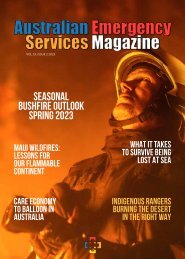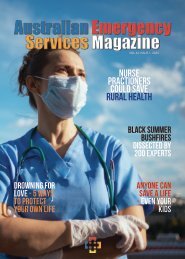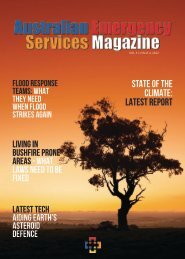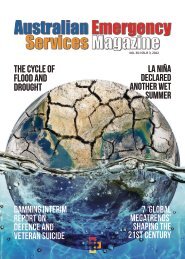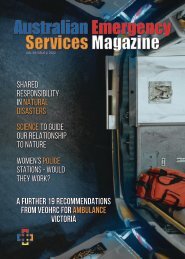Vol. 2 Issue 1. 2017
The Australian Emergency Services Magazine is a community educational resource dedicated to the recognition and promotion of emergency service personnel, and the awareness of safety measures, for the community, family and individual. We aim to provide relevant and up to date information and advancements within each of the emergency response sectors and first responders.
The Australian Emergency Services Magazine is a community educational resource dedicated to the recognition and promotion of emergency service personnel, and the awareness of safety measures, for the community, family and individual. We aim to provide relevant and up to date information and advancements within each of the emergency response sectors and first responders.
Create successful ePaper yourself
Turn your PDF publications into a flip-book with our unique Google optimized e-Paper software.
Summer 2016 VOL 2<br />
WHEN WILL IT RAIN?<br />
NATURAL<br />
DISASTERS<br />
AFFECT OUR<br />
MOST<br />
VULNERABLE<br />
SUMMER<br />
FESTIVAL<br />
SURVIVAL<br />
GUIDE<br />
FIRESTORMS<br />
What you<br />
need to<br />
know<br />
SUBSTANCE<br />
ABUSE AND<br />
FAMILY<br />
VIOLENCE
Mate helping Mate<br />
Neighbour helping Neighbour<br />
People helping People<br />
132 500 Fact Sheet<br />
For emergency help in floods and storms<br />
Need emergency help in floods and storms?<br />
If you need the assistance of the State Emergency Service in<br />
non-life threatening emergency situations during floods and<br />
storms, you can:<br />
• Call 132 500; or<br />
• Lodge a request here: www.132500.qld.gov.au; Or<br />
• Lodge a request on our 132 500 SES Assistance App available<br />
for both Apple and Android devices.<br />
SES volunteers help protect people and properties from storms<br />
in QLD by:<br />
• Educating people about how to protect their family and<br />
property from floods and storms<br />
• Temporarily repairing properties from further hail, heavy<br />
rain or strong wind<br />
• Clearing roads and property to give emergency access<br />
• Rescuing people trapped or injured by flood or storm activity<br />
• Providing emergency assistance in flood situations<br />
??How can I help??<br />
R Use a BUCKET to capture leaking water<br />
R MOVE furniture from under leaks<br />
R Internally TARP furniture<br />
R SANDBAG entry points to your<br />
house/business<br />
R HELP your neighbours<br />
R HELP your family<br />
Handy Hints<br />
P SES volunteers carry<br />
out temporary repairs in<br />
emergency situations<br />
P Property owners should<br />
seek professional trades<br />
people to permanently<br />
repair any damage caused<br />
by storms or floods<br />
P It is the responsibility of<br />
the landowner to remove the<br />
debris from their property<br />
Call<br />
132 500<br />
Australia<br />
Wide!<br />
If your emergency<br />
is life threatening<br />
call 000 (triple zero)<br />
For more information, contact us as per below:<br />
© State of Queensland (Queensland Fire and Emergency Services) 2016<br />
All Queensland Fire and Emergency Services material in this document – except any material protected by a trademark, and<br />
unless otherwise noted – is licensed under a Creative Commons Attribution 4.0 licence<br />
www.ses.qld.gov.au
CONTENTS<br />
Editor’s Note<br />
Latest Events<br />
• Police recognised for<br />
commitment & service<br />
• New Sapol App<br />
launched<br />
Emergency Kit Essentials<br />
Firestorms<br />
NSW Police support<br />
CrashCard<br />
Bushfire - Prepare before<br />
the season<br />
Natural Disasters affect<br />
the disadvantaged<br />
Managing Stress after<br />
Disaster<br />
Alcohol & drug use<br />
exacerbate family<br />
violence<br />
Surviving Summer<br />
Festivals<br />
Ecotide - Bushfire event<br />
planning<br />
1<br />
2<br />
4<br />
5-6<br />
7-8<br />
9<br />
11-14<br />
15-18<br />
19-20<br />
20-22<br />
24-26<br />
27<br />
The Australian Emergency Services Magazine is a community educational<br />
resource and does not promote itself as a charity or fund raising institution,<br />
nor solicit on behalf of charities and is no way financially supported by<br />
or associated with any government or similar institution. Distributions of<br />
the publication is Quarterly and are circulated via a database of interested<br />
parties, including business, subscribers, advertisers, volunteer emergency<br />
organistations, and council library’s. A digital eMag is distributed to a<br />
targeted database in each State & Territory. All information published in<br />
the Australian Emergency Services Magazine is in good faith and whilst<br />
every effort is made to ensure that the publication is free of error and<br />
omission, no responsibility or liability will be accepted by Boothbook Pty<br />
Ltd.<br />
Emergency Contacts<br />
Apps to help in emergency<br />
30<br />
31<br />
Published by Boothbook Media<br />
ABN:72 605 987 031<br />
www.boothbookmedia.com.au<br />
Email: contact@boothbookmedia.com.au
EDITORS NOTE<br />
Welcome to <strong>Vol</strong>ume 2 of our<br />
Summer edition for 2016 and isn’t<br />
Summer well and truly upon us?<br />
The Christmas holiday rush<br />
and a new year just around the<br />
corner has everyone trying to<br />
find the balance between relaxing,<br />
recharging and getting some<br />
things done while we have a break.<br />
We hope you are managing to do<br />
this successfully!<br />
It has been yet another eventful<br />
beginning of the summer storm<br />
season with many communities<br />
taking a battering and our<br />
emergency services volunteers<br />
being on the ready.<br />
In the southern parts of the<br />
country they have seen snow<br />
whilst in the red centre, Uluru is<br />
teeming with majestic rainfalls<br />
after a deluge of rain fell in central<br />
Australia over the last week that<br />
has left communities isolated.<br />
However there are still many<br />
communities doing it tough and<br />
asking the question, When will<br />
it rain? Scouring the bureau and<br />
checking long range forcasts for<br />
any sign of that liquid gold to feed<br />
crops and livestock.<br />
The diversity of conditions and<br />
community needs our emergency<br />
services contend with across this<br />
great country of ours couldnt be<br />
more on display than they have<br />
during the first month of Summer.<br />
It is a perfect opportunity to<br />
say thank you to those men and<br />
women who work tirelessly within<br />
our emergency services, many of<br />
whom are at the front line, facing<br />
personal dangers in order to<br />
protect and keep us safe.<br />
We hope you have enjoyed time<br />
with loved ones over Christmas<br />
and are looking forward to a<br />
happier, healthier, safer and more<br />
prosperous <strong>2017</strong>.<br />
From all of us here at the<br />
Australian Emergency Services<br />
Magazine we wish you a Happy<br />
New Year!<br />
Emma Parker<br />
Editor<br />
1
RECOGNITION OF<br />
COMMITMENT AND<br />
SERVICE<br />
LATEST NEWS<br />
Minister for Police, Fire and<br />
Emergency Services Mark Ryan and<br />
Commissioner Ian Stewart have<br />
congratulated Queensland Police<br />
Service (QPS) officers and staff who<br />
received medals and awards at a<br />
ceremony held at Police Headquarters<br />
in Brisbane today.<br />
The ceremony included the 2016<br />
Adopt-a-Cop awards, with the<br />
Adopt-a-Cop program involving<br />
the voluntary appointment of police<br />
officers to schools and other relevant<br />
organisations with the primary goal of<br />
building positive relationships between<br />
police and members of the school<br />
community.<br />
The overall Adopt-a-Cop of the Year<br />
award went to Constable Stephen<br />
Armstrong from the Fernvale<br />
State School, where he has been<br />
instrumental in building police, school<br />
and community relations in a short<br />
period. His determined efforts in<br />
implementing programs and continued<br />
support have actively promoted the<br />
values and beliefs of both the school<br />
and the QPS.<br />
Officers from each of the five regions<br />
were recognised, with Constable<br />
Armstrong nominated from the<br />
Southern Region.<br />
Also awarded for his conscientious<br />
efforts was Senior Constable Wade<br />
Hastie from the Northern Region, for<br />
his consistent preparedness to achieve<br />
more than the role usually entails at the<br />
Ravenswood State School.<br />
Inspector Grant Marcus received the<br />
award for his valuable work at St Luke’s<br />
Anglican School in the Central Region,<br />
where he has advocated a multitude<br />
of safety, education and counselling<br />
programs over his 15 years as an<br />
Adopt-a-Cop.<br />
Senior Constable Troy Hews from the<br />
Brisbane Region received his regional<br />
award for the positive relationships he<br />
progressively developed with students<br />
at Oakleigh State School, at both a<br />
formal and in-formal level.<br />
Constable Natalie Wilson received the<br />
Adopt-a-Cop for the South Eastern<br />
Region, where she works tirelessly at<br />
Boronia Heights State School to break<br />
down barriers that prevent positive<br />
relationships between students and the<br />
police. Commissioner Stewart praised<br />
the efforts of all Adopt-a-Cops in<br />
schools around the state.<br />
“The outstanding level of dedication<br />
pursued in volunteering for this<br />
program highlights the exemplary core<br />
values present in each of these officers,”<br />
Commissioner Stewart said.<br />
2
“The contribution of Adopt-a-Cops is<br />
invaluable to the communities in which<br />
they serve and to the Service.”<br />
Police Minister Ryan presented 20<br />
past and present officers with the<br />
National Police Service Medal in<br />
acknowledgement of their commitment<br />
to ethical and diligent service. This<br />
award recognises the special status<br />
sworn police officers have because of<br />
their role protecting the community.<br />
The National Medal recognises 15<br />
years of diligent service by members of<br />
Australian police forces, defence forces,<br />
and members of the ambulance and fire<br />
services. Clasps to the National Medal<br />
are awarded for a further period of 10<br />
years’ service.<br />
Police Minister Ryan presented Deputy<br />
Commissioner Steve Gollschewski,<br />
Deputy Commissioner Peter Martin,<br />
Detective Inspector John James,<br />
Inspector James Walsh.<br />
Commissioner Stewart presented<br />
Senior Sergeant John Goldsworthy with<br />
his 40 year clasp to the QPS Medal and<br />
Inspector Peter Assfalg and Ms Mary-<br />
Lou Webster with their clasps for 35<br />
years of dedicated service.<br />
exemplary attributes as a member<br />
of the Queensland Police Service,”<br />
Commissioner Stewart said.<br />
“It is through these awards today that<br />
we acknowledge and thank them for<br />
their dedication and diligence.<br />
The Queensland Police Meritorious<br />
Service Medal is awarded to a<br />
QPSmember who has provided a<br />
continued substantial contribution in<br />
a number of areas within the QPS over<br />
an extended period of time.<br />
This medal was awarded to Ms Pamela<br />
Furner, an Administration Officer who<br />
has worked diligently with the Ethical<br />
Standards Command for 17 years.<br />
In this role, Ms Furner continually<br />
performs her duties to a very high<br />
standard, assisting investigating officers<br />
and senior members of the Command<br />
on a daily basis.<br />
Detective Senior Sergeant Gary Pearce,<br />
Senior Sergeant Mark Ruggeri and<br />
Detective Senior Sergeant Chris Toohey<br />
with their 2nd Clasp of the National<br />
Medal acknowledging 35 years’ service,<br />
with a further nine officers receiving<br />
their first clasp for 25 years’ service,<br />
and 11 officers receiving the medal for<br />
the first time for 15 years of dedicated<br />
service. Today’s ceremony also saw<br />
the Queensland Police Service Medal<br />
presented to a number of officers and<br />
staff members. The QPS Medal is an<br />
award approved by the Commissioner<br />
in recognition of diligent and ethical<br />
service by QPS employees after 10 years<br />
of full-time qualifying service.<br />
Eight officers were awarded the<br />
Queensland Police Service Medal for<br />
the first time, with the medal awarded<br />
posthumously to the Late Detective<br />
Sergeant Leonard Hooper and the late<br />
Commissioner Stewart acknowledged<br />
the devotion and tireless effort of the<br />
ceremony’s award recipients.<br />
“Through the duration of their<br />
careers each recipient has displayed<br />
QPS Media<br />
© State of Queensland (Queensland Police Service)<br />
2016<br />
3
SAPOL MOBILE PORTAL APP<br />
LAUNCHED<br />
A new “one stop” mobile portal app<br />
was launched today by the South<br />
Australia Police, bringing easier access<br />
to key police apps through one portal.<br />
Deputy Police Commissioner Linda<br />
Williams says the new mobile portal<br />
app means people will now only need<br />
to download a single app to access<br />
a range of specialist police apps and<br />
information services.<br />
“Police have a number of web-based<br />
information services and apps that<br />
provide the community with critical<br />
services and information.<br />
“The mobile portal app now provides<br />
a single portal to download, that can<br />
then be tapped to access other linked<br />
icons, taking the user straight to the<br />
service or information they are seeking.<br />
“This “one stop” approach is designed<br />
to help people save time and reduce<br />
any confusion in getting to services<br />
and information available across our<br />
platforms.<br />
“Providing a quick, responsive policing<br />
service relies heavily on the timeliness<br />
and accuracy of information we<br />
receive. Any process that simplifies<br />
and speeds up how people report<br />
emergencies or information to us,<br />
therefore also helps police.”<br />
Services available through the mobile<br />
portal app include calling the 131 444<br />
police assistance line, with a map of the<br />
caller’s current location displayed to<br />
make it easier to check location details.<br />
Triple Zero can also be called, with the<br />
caller confirming it is an emergency<br />
before the call proceeds.<br />
Other apps accessible through the new<br />
portal will help people report certain<br />
crimes and track their crime reports,<br />
find the nearest police station and even<br />
check out where a fixed speed camera<br />
is located.<br />
Further, for all the latest police news,<br />
the app provides a direct link to<br />
SAPOL’s social media feeds and news<br />
pages.<br />
The mobile portal app is available free<br />
from the Google Play Store and the<br />
Apple App Store and is compatible<br />
with devices using Apple iOS 7 version<br />
and higher and the Android operating<br />
system version 4 and higher.<br />
What’s available through the mobile<br />
portal app:<br />
Police Assistance<br />
Initiate a call to the Police Assistance<br />
Line 131 444 - displays a map showing<br />
the street details of user’s current<br />
location.<br />
Triple Zero<br />
Initiates a call to the emergency triple<br />
zero (000) number. Prior to the call<br />
being made, a message is displayed<br />
asking the user to confirm it is an<br />
emergency.<br />
Report suspicious behaviour<br />
Submit an initial report to the Crime<br />
Stoppers SA Online Reporting System<br />
web page.<br />
Track My Crime<br />
A SAPOL developed web app, where<br />
victims can check the progress of<br />
their investigation by entering their<br />
police incident report number and the<br />
incident date.<br />
Police social media<br />
Opens a screen to navigate to one of<br />
SAPOL’S social media feeds; Facebook,<br />
Twitter or YouTube.<br />
SAPOL News<br />
Opens the SA Police News web page<br />
in the device browser for all the latest<br />
police news.<br />
SAPOL website<br />
Opens the main SA Police web page in<br />
the device browser.<br />
Find the nearest police station<br />
Displays on a map the closest police<br />
station to the user’s current location.<br />
It is also possible to find and display<br />
the location of a police station based on<br />
suburb search criteria.<br />
This feature is available even if the<br />
device does not have access to the<br />
internet.<br />
Fixed speed camera locations<br />
Displays on a map fixed safety cameras<br />
located near the user’s current location.<br />
It is also possible to find and display the<br />
location of a fixed safety camera based<br />
on suburb search criteria.<br />
This feature is available even if the<br />
device does not have access to the<br />
internet.<br />
Youth safety displays<br />
Information on antisocial behaviour,<br />
cyber safety, graffiti, school vandalism<br />
and shop theft.<br />
© South Australia Police, Government of South<br />
Australia 2014<br />
4
EMERGENCY KIT<br />
ESSENTIALS<br />
HAVING AN EMERGENCY KIT IS AN IMPORTANT STEP TO<br />
PREPARE FOR, SURVIVE AND COPE WITH EMERGENCIES.<br />
Know<br />
All householders need to<br />
know where your<br />
Emergency Kit is kept.<br />
On this page is a list of items which should be in your<br />
kit at all times. There is also a list of extra items which<br />
if you do not keep at all times you should add to your<br />
kit during storm or cyclone season.<br />
FOOD AND WATER<br />
COMMUNICATIONS<br />
Check<br />
and update the contents<br />
of your kit regularly, to<br />
ensure everything is in<br />
working order and has<br />
not expired.<br />
Discuss<br />
your Emergency Kit<br />
with all householders<br />
and make sure everyone<br />
knows what to do in an<br />
emergency.<br />
KNOW YOUR<br />
EMERGENCY<br />
CONTACTS<br />
Range of non-perishable<br />
MEDICAL AND<br />
SANITATION<br />
food items<br />
Bottled water<br />
First Aid Kit and manual<br />
Essential medications,<br />
prescriptions and dosage<br />
Toilet paper<br />
Toothbrush/toothpaste<br />
Soap/shampoo<br />
Personal hygiene items<br />
LIGHT<br />
Flashlight/torch with<br />
extra batteries<br />
Battery powered lantern<br />
Battery powered radio with<br />
extra batteries<br />
Traditional wired telephone<br />
Prepaid wired telephone<br />
Prepaid phone cards and<br />
coins for phone calls<br />
CLOTHING AND<br />
FOOTWEAR<br />
Warm jumper, waterproof<br />
jacket, hat and gloves<br />
for everyone<br />
Closed-toed shoes or<br />
boots for everyone<br />
TOOLS AND SUPPLIES<br />
Whistle, utility knife,<br />
duct/masking tape<br />
5
Plastic garbage bags, ties<br />
Safety glasses and sun glasses.<br />
MISCELLANEOUS<br />
Special items for infants<br />
(nappies, formula etc)<br />
Special items needed by<br />
elderly or people with<br />
special needs<br />
Spare house and car keys<br />
Pet food, water and<br />
other animal needs<br />
IMPORTANT DOCUMENTS<br />
Keep original or certified copies of<br />
these documents in your Emergency<br />
Kit.<br />
Scan copies of them and save the<br />
files on a USB memory stick or CD<br />
to include in your kit. Keep all these<br />
items in sealed plastic bags.<br />
Insurance papers for your<br />
house and contents, cars<br />
and for valuable items<br />
Inventory of valuable<br />
household goods<br />
Wills and life insurance documents<br />
House deeds/mortgage documents<br />
Birth and marriage certificates<br />
Passports/visa details<br />
Stocks and bonds<br />
Medicare, pension cards,<br />
immunisation records<br />
Bank account and credit card details<br />
A back-up copy of important<br />
computer files<br />
Household Emergency Plan with<br />
emergency contact numbers<br />
FOR MORE INFORMATION AND TO DOWNLOAD AN<br />
EMERGENCY PLAN FOR YOUR HOUSEHOLD GO TO:<br />
www.qld.gov.au/emergency/dealing-disasters/emergency-kit<br />
6
FIRESTORMS<br />
The bushfire/thunderstorm hybrids we<br />
urgently need to understand<br />
The journal Climatic Change has published a special edition of review<br />
papers discussing major natural hazards in Australia. This article is<br />
one of a series looking at those threats in detail.<br />
Fire has been a driving force across<br />
Australia for millennia. Indeed, the<br />
health of many of our ecosystems is<br />
intrinsically dependent on fire. But<br />
bushfires are also one of our most<br />
frequent natural hazards, with a total<br />
cost estimated at A$340 million per<br />
year.<br />
In the past decade or so, extreme<br />
bushfires in southeastern Australia<br />
have burned more than a million<br />
hectares, claiming more than 200 lives<br />
and over 4,000 homes. Similar losses in<br />
other major urban areas have prompted<br />
questions about whether we are seeing<br />
a shift towards a significantly more<br />
hazardous fire regime, characterised by<br />
increasing fire frequency and intensity,<br />
and the development of catastrophic<br />
“firestorms”.<br />
While these extreme bushfires account<br />
for only a very small percentage of fire<br />
events, they are responsible for the<br />
lion’s share of bushfire-related losses.<br />
In contrast to typical bushfires, which<br />
spread across the landscape as welldefined<br />
burning fronts with smoke<br />
plumes perhaps a few kilometres<br />
high, extreme bushfires exhibit deep<br />
and widespread flaming and produce<br />
smoke plumes that can extend 10-<br />
15km into the atmosphere.<br />
At these altitudes, bushfire plumes can<br />
actually develop into thunderstorms<br />
(hence the term “firestorm”). As such,<br />
extreme bushfires become much more<br />
difficult for emergency services to<br />
handle, making them all but impossible<br />
to suppress and their spread difficult to<br />
predict.<br />
Beyond hot, dry and windy<br />
Like other dangerous bushfires,<br />
firestorms are driven by hot, dry<br />
and windy weather. But to spawn a<br />
firestorm, a range of other conditions<br />
must also be met; these can include a<br />
rugged landscape, particularly nasty<br />
weather events that produce “spikes” in<br />
fire danger, and conditions in the upper<br />
atmosphere that allow fire plumes to<br />
grow to considerable heights.<br />
While previous studies have considered<br />
past and projected changes in the hot,<br />
dry and windy aspect of fire danger,<br />
less research has been done on the<br />
future projections for these other types<br />
of conditions. This means that we have<br />
quite a poor understanding of how<br />
extreme bushfires might affect us in the<br />
future.<br />
As part of a series of reviews produced<br />
by the Australian Energy and Water<br />
Exchange initiative, my colleagues and<br />
I have taken a closer look at the most<br />
catastrophic bushfire cases and the<br />
factors that drive them, beyond the<br />
usual hot, dry and gusty weather.<br />
There has been an overall increase<br />
7
in the frequency of major bushfire<br />
events in southeastern Australia since<br />
the mid-19th century. In particular,<br />
in the past 15 years a major fire event<br />
has occurred every 5 years or less.<br />
While some of this increase is due to<br />
changes in land use since European<br />
colonisation, there is also strong<br />
evidence of climate-driven changes.<br />
We found that besides increases<br />
in dangerous surface fire danger<br />
conditions, upper atmospheric<br />
conditions have also become more<br />
conducive to explosive fire growth.<br />
High levels of the c-Haines index,<br />
which signals greater potential for<br />
a fire’s plume to rise high into the<br />
atmosphere, have become considerably<br />
more prevalent since the 1980s. The<br />
effects of droughts and widespread<br />
heatwaves have also contributed to the<br />
occurrence of extreme bushfires.<br />
Looking into the future, high c-Haines<br />
values are projected to grow more<br />
prevalent still, albeit more gradually<br />
than over recent decades. Frontal<br />
weather patterns associated with<br />
particularly bad fire days are also<br />
projected to become more frequent<br />
during this century, and rainfall is<br />
projected to decrease over southwest<br />
and southeastern Australia.<br />
All of this suggests that extreme<br />
bushfires will become a more common<br />
occurrence into the future.<br />
What we still don’t know<br />
Our methods for assessing fire danger<br />
do not explicitly account for the effects<br />
of extended drought and heatwaves on<br />
larger fuel elements such as branches<br />
and logs, and so may not properly<br />
account for their effects on fire spread<br />
and heat release into the atmosphere.<br />
There is also considerable uncertainty<br />
about how fuel loads will change into<br />
the future. It is possible that the higher<br />
fire intensities expected to result from<br />
the direct effects of a warmer, drier<br />
climate may be offset by lower fuel<br />
loads.<br />
Our understanding of extreme fire<br />
occurrence is also hampered by the<br />
lack of long-term and prehistoric<br />
climate data, which makes it hard<br />
to work out what the “normal” level<br />
of extreme bushfires has been in the<br />
past. While charcoal records show<br />
promise in this regard, we still don’t<br />
know enough about how charcoal is<br />
generated, deposited and subsequently<br />
preserved during extreme fires.<br />
To predict the future occurrence of<br />
extreme bushfires, we also have more<br />
work to do in understanding how<br />
the trends forecast by global climate<br />
models will play out in terms of<br />
creating regional-scale fire weather<br />
conditions. And we still need to figure<br />
out the likely effects of other large-scale<br />
patterns such as El Niño.<br />
Given the relatively recent advances<br />
that have been made in understanding<br />
the key drivers of extreme bushfires,<br />
the field is now ready for targeted<br />
studies that will help us estimate the<br />
future risk of extreme bushfires – and<br />
how best we can confront the threat.<br />
_This article was amended on<br />
November 11, 2016, to correct the<br />
figure for the cost of bushfire-related<br />
damage. The correct figure is A$340<br />
million, not A$8.5 billion which is the<br />
annual cost of all fire-related damage in<br />
Australia.<br />
Jason Sharples<br />
UNSW Australia<br />
Origianlly published on The Conversation<br />
Australia Ltd<br />
www.imcdgroup.com<br />
Detergents Pharmaceuticals Personal Care<br />
IMCD is a global leader in the sales, marketing<br />
and distribution of speciality chemicals and food<br />
ingredients. Through our technical, marketing<br />
and supply chain expertise we bring added<br />
value and growth to both our customers and<br />
principal partners throughout the world.<br />
Coatings<br />
Home care, industrial<br />
care and institutional care<br />
Pharmaceutical synthesis, innovative (brand)<br />
pharmaceuticals, generic pharmaceuticals,<br />
neutraceuticals or food supplements, veterinary<br />
Colour cosmetics, dental, deodorants,<br />
fragrances, hair care, skin care and toiletries<br />
Adhesives, construction inks,<br />
industrial coatings, paints<br />
Food & Nutrition<br />
Lubricants<br />
Synthesis<br />
Plastics<br />
Bakery, beverages, confectionary,<br />
dairy, edible oils & fats, nutrition,<br />
savoury, animal nutrition<br />
Automotive, industrial,<br />
fuel & refinery<br />
Resins, polymers, esters, plasticisers,<br />
pigments & dyes, surfactants,<br />
floculants, various additives<br />
Compounders, converters, rubbers,<br />
polyurethanes and composites<br />
IMCD Australia firmly believes in offering innovative solutions that meet sustainable demands as well as making a positive contribution to its local communities.<br />
Block 6/113 Unwin Street ROSEHILL NSW 2142 02 9897 6100<br />
8
THE CARD THAT CAN<br />
SAVE LIVES<br />
A crash card carrying personal<br />
information can be stored by<br />
motorcyclists in their helmets.<br />
The NSW Police Force has thrown its<br />
support behind<br />
a simple initiative that could save<br />
the lives of motorcyclists involved in<br />
crashes.<br />
The Motorcycle Crash Card is<br />
a small card that motorcyclists<br />
and their passengers can carry in<br />
their helmets. The card provides<br />
emergency service personnel with<br />
the rider’s personal information,<br />
which in the case of an accident could<br />
save valuable time and help with<br />
treatment, especially if the rider is<br />
unconscious or unable<br />
to communicate.<br />
Commander of Traffic & Highway<br />
Patrol, Assistant Commissioner<br />
John Hartley praised the initiative,<br />
pointing out that of the 206<br />
people who lost their lives on the<br />
road in the first half of 2016, 30 were<br />
motorcyclists.<br />
“There are more than one million<br />
people riding motorcycles each<br />
week and far too<br />
many people are<br />
losing their lives,” he said. “If<br />
Motorcycle Crash Cards save one<br />
life, the scheme will have proved<br />
worthwhile.<br />
“While safe riding and wearing<br />
proper clothing greatly reduces<br />
their chances of being involved in a<br />
crash, but if that does happen, this<br />
is a simple step they can take that<br />
could save their life or help with their<br />
treatment.”<br />
The Motorcycle Crash Card scheme<br />
was first created in 2009 by a<br />
paramedic in the UK and has been<br />
produced in NSW by Hornsby Shire<br />
Council with support from the NSW<br />
Police Force, NSW Ambulance and<br />
Fire & Rescue NSW.<br />
The rider completes the details on<br />
the card and places it in the lining of<br />
their helmet. A red sticker is placed<br />
on the outside of the<br />
helmet to alert emergency services, in<br />
the case of an accident, that there is a<br />
card within the helmet.<br />
The information contained on<br />
the card can be vital to attending<br />
paramedics and can include the<br />
rider’s current medical history and<br />
details of any medication currently<br />
being taken. It also has space for the<br />
contact details of a next of kin, which<br />
is important given a rider’s phone is<br />
often locked or can be damaged, and<br />
their wallet can be<br />
easily be separated from the rider in<br />
the event of a crash.<br />
However, Assistant Commissioner<br />
Hartley warned that the cards are<br />
designed to be used by medical<br />
professionals only.<br />
“You should never try to remove<br />
someone’s helmet at the scene<br />
of a crash unless they are having<br />
trouble breathing,” he said.<br />
Riders can order the crash card<br />
online free of charge on the Hornsby<br />
Shire Council website.<br />
‘© State of New South Wales (NSW Police Force).<br />
For current information go to Crash Card<br />
9
MAJOR AUSTRALIAN OPERATOR OF PASSENGER LAND TRANSPORT<br />
PLAN YOUR JOURNEY AND VIEW TIMETABLE<br />
INFORMATION<br />
www.cdcbus.com.au<br />
HILLSBUS<br />
QCITY<br />
HUNTER VALLEY<br />
CDC VICTORIA<br />
SCHOOL SERVICES<br />
CHARTER SERVICES<br />
29 FOUNDRY ROAD SEVEN HILLS NSW CUSTOMERSERVICE@CDCBUS.COM.AU 02 9890 0000<br />
GOLD COAST<br />
SAILING CHARTERS<br />
0409 133 008<br />
www.goldcoastsailingcharters.com.au<br />
Cruises to Stradbroke Island, Couran Cove,<br />
Wavebreak and Sanctuary Cove<br />
61 Seaworld Drive MAIN BEACH QLD<br />
SUNSET CRUISES REGULAR CHARTERS<br />
STAFF FUNCTIONS<br />
PARTIES<br />
MEMORIAL SERVICES<br />
www.sealy.com.au<br />
Morning & Afternoon Tea<br />
BBQ Facilities onboard<br />
BYO Alcohol<br />
Refreshments (Water, Soft Drink)<br />
Toilets onboard<br />
info@goldcoastsailingcharters.com.au<br />
Over 75 years of setting the standard in quality bedding<br />
MANUFACTURER<br />
1299 BOUNDARY ROAD WACOL QLD<br />
07 33315200 gbatchelor@sealy.com.au<br />
10
PREPARE BEFORE THE SEASON<br />
Getting ready for a bush fire is easier than you think. By taking 20 minutes<br />
with your family to discuss what you’ll do during a fire, you could save their<br />
lives, as well as your home. Many households find that having a discussion<br />
over dinner works best as everybody is together and focussed. There are<br />
simple things you can do around your home to prepare it for a bush fire, like<br />
keeping the grass low and having a cleared area around your home. If there is<br />
a fire in your area you will find its alert level on your local government website<br />
or the ‘Fires Near Me’ app. You need to keep track of the alert level so you<br />
know what you should do. In a bush fire, it’s important that you stay up to date<br />
on conditions in your area.<br />
ARE YOU AND<br />
YOUR FAMILY AT<br />
RISK?<br />
WHAT WILL YOU<br />
DO TO KEEP<br />
SAFE?<br />
QUESTIONS TO ASK<br />
YOURSELF<br />
When will we leave?<br />
Where will we go?<br />
How will we get there?<br />
What will we take?<br />
Who will we call to tell that we’re<br />
leaving and that we have arrived<br />
safely?<br />
11<br />
What is our backup plan?<br />
Neighbourhood Safe Places are a<br />
place of last resort, such as a sports<br />
ground or local building that has<br />
been specially identified for use<br />
during a fire.<br />
Contact your local area to find out<br />
about neighbourhood safe places.<br />
LEAVING EARLY OR PREPARING TO STAY?<br />
One of the most important things to do before a bush fire is to decide what<br />
you’ll do if one should start.<br />
If you plan to leave for a safer place - where will you go and how will you get<br />
there? Your safer place could be with friends and family, and may not be far<br />
away. Know where you will go and never ‘wait and see’.<br />
Decide to stay only if you are well prepared. Before you start, ask your<br />
household:<br />
• Is your home well prepared to make it as safe as possible during a fire?<br />
• Are we putting anyone in our family at risk by staying?<br />
For example children, the elderly, or people with asthma.<br />
• Will we cope in an emergency situation? In a fire, it will be hot, smoky and<br />
physically draining. Even trained firefighters can find it challenging.<br />
If you’re not sure or aren’t prepared, you should leave early.
IF YOU DECIDE TO<br />
STAY ASK THESE<br />
QUESTIONS<br />
Do we have all the equipment we<br />
need?<br />
When there is a fire, what is our<br />
sign to start defending our home?<br />
Do we know what to do<br />
BEFORE, DURING and AFTER<br />
a fire?<br />
It’s not safe to stay with your property under some circumstances, like:<br />
• If the fire danger rating is Catastrophic.<br />
• There is an Extreme fire danger rating and your home is not specially designed<br />
or constructed for bush fires.<br />
• Your property is not well maintained.<br />
• You or the people in your home aren’t mentally and physically fit and ready.<br />
Under these circumstances, you should leave early.<br />
Remember that bush and grass fires can move quickly and catch you off guard.<br />
If you are caught in a fire, protect yourself from the heat.<br />
The safest option is to leave early before the fire reaches you.<br />
DECIDE TO STAY, BUT BE PREPARED<br />
Defending your home from a bush fire can be challenging and you will need<br />
the right equipment. Check off all the equipment you will need in a bush fire<br />
emergency.<br />
Remember, while firefighters and emergency services will do everything they<br />
can to help you, there’s no guarantee that there will be a fire truck available<br />
when you need it. If you decide to stay with your property, it’s your responsibility<br />
to be prepared.<br />
Do all members of our household<br />
KNOW WHAT TO DO in all<br />
situations?<br />
What is our backup plan?<br />
PREPARE YOUR BUSHFIRE<br />
SURVIVAL PLAN<br />
All state government websites<br />
have downloadable copies of<br />
bushfire survival plans. These<br />
guides will give you checklists<br />
and points of discussion to go<br />
over with your household. It is<br />
important that all members of<br />
the house understand what is<br />
in the survival plan and what<br />
the back up plan is. This could<br />
help save lives and your property<br />
during this bushfire season.<br />
Look up bushfire safety on your<br />
state government website to find<br />
out more.<br />
EQUIPMENT CHECKLIST<br />
FIREFIGHTING EQUIPMENT WE WILL NEED:<br />
[ ] A hose, or hoses, that can reach all around the house<br />
[ ] Water supply of at least 10,000L e.g. water tank, dam, pool<br />
[ ] Petrol/diesel water pump and fuel in a safe, accessible place<br />
[ ] Ladders to access inside the roof<br />
[ ] Buckets and mops<br />
[ ] Shovels and metal rakes<br />
12
PREPARING YOUR<br />
HOME<br />
Block up areas where embers<br />
can enter the house<br />
Install metal fly screens on all<br />
windows and vents<br />
Install metal gutter guards<br />
Position gas cylinders on side<br />
of house and<br />
away from trees and gardens<br />
Direct any pressure valves<br />
away from house<br />
Move garden beds away from<br />
house<br />
Replace wood fences with<br />
metal fences<br />
Use stones instead of mulch<br />
[ ] Wide-brimmed hat<br />
[ ] Eye protection goggles<br />
[ ] Moistened facemask or cloth<br />
[ ] Loose, long sleeved cotton shirt<br />
[ ] Gloves<br />
[ ] Long cotton pants/jeans<br />
[ ] Sturdy leather shoes or boots<br />
PROTECTIVE CLOTHING<br />
DECIDE TO STAY, BUT BE PREPARED Cont.<br />
ACTION CHECKLIST<br />
Defending your home can be physically and mentally demanding. It’s important<br />
that everyone knows exactly what to do if a fire happens.<br />
OUTSIDE:<br />
BEFORE (well before the fire has arrived)<br />
Turn off gas mains and/or bottle<br />
Move flammable items away from the house<br />
Block drain pipes with socks full of sand and fill gutters with water. Don’t get<br />
on the roof to hose it down<br />
Move animals to a well-grazed or ploughed area away from the house and<br />
wind<br />
Patrol the house well before the fire arrives to put out embers and spot fires<br />
As the fire approaches, wet the side of the house and garden that faces the fire<br />
Move your firefighting equipment to a place where it won’t burn inside<br />
INSIDE:<br />
Close doors, windows and vents<br />
Fill baths, sinks, buckets and bins with water<br />
Confine pets to one room<br />
Place ladder next to roof access hole so you can check for spot fires<br />
Soak towels and rugs<br />
and lay them across external doorways<br />
Move furniture away from windows<br />
DURING (as the fire is upon you)<br />
If flames are on top of you or the heat become unbearable move inside until<br />
the fire front has passed (usually 5-10 minutes)<br />
Patrol the inside of the house, including roof space, looking for sparks and<br />
embers<br />
Shelter in a room on the opposite side of the house from the approaching fire<br />
and ensure you have clear access to an exit<br />
13
<br />
AFTER (immediately after the fire has passed)<br />
Check the house both inside and out for fires, including roof cavity, under the<br />
house, deck, stairs, windowsills etc<br />
If possible, and safe to do so, check all your neighbours are OK<br />
Contact relatives or friends to tell them you are safe<br />
Patrol your home for several hours, looking for small fires and burning embers<br />
<br />
PREPARE YOUR HOME AND PROPERTY<br />
There are some simple things you can do around your home to prepare it for a<br />
bush fire. You need to prepare well beforehand as leaving it to the last minute<br />
is too late.<br />
Here are five simple things you can do before and during the bush fire season.<br />
<strong>1.</strong> TRIM<br />
Trim overhanging trees and shrubs. This can stop the fire spreading to your<br />
home.<br />
2. MOW<br />
Mow grass and remove the cuttings. Have a cleared area around your home.<br />
3. REMOVE<br />
Remove material that can burn around your home (e.g. Door mats, wood<br />
piles, mulch, leaves, paint, outdoor furniture).<br />
4. CLEAR<br />
Clear and remove all the debris and leaves from the gutters surrounding your<br />
home. Burning embers can set your home on fire.<br />
5. PREPARE<br />
Prepare a sturdy hose or hoses that will reach all around your home. Make<br />
sure you’ve got a reliable source of water.<br />
KNOW YOUR RISK<br />
A bush or grass fire can happen at any time of the year but the risk is<br />
higher during the warmer months, when bush, grass or scrub is drier.<br />
You don’t have to live right near the bush to be at risk. Even if your<br />
home is a few streets back, you may be at risk.<br />
You can check for bush fire prone areas in your area on your local council<br />
website. Look for your Bush Fire Prone Land Map.<br />
PREPARE YOUR RURAL<br />
PROPERTY<br />
Remove overhanging branches<br />
from power lines<br />
Ensure that a fire tanker can<br />
access your property<br />
Clear fire breaks along paddock<br />
boundaries<br />
Store petrol, diesel and gas away<br />
from home<br />
Keep a well-maintained area<br />
around the home and sheds<br />
Place water pipes from dams<br />
underground and install pump<br />
to the house<br />
Make sure hoses have spray<br />
nozzles<br />
Keep water tanks full and<br />
connect them to pumps<br />
A CLEARED AREA<br />
AROUND YOUR HOME<br />
CAN SLOW A FIRE<br />
SPREADING AND GIVE<br />
FIREFIGHTERS A SAFE<br />
AREA TO WORK.<br />
There are a number of things which can affect the way a fire burns,<br />
including:<br />
SLOPE – a fire travelling uphill will travel faster. In fact, for every 10 degrees<br />
of slope, a fire can double its speed. As a fire speeds up, it becomes<br />
more intense and more dangerous.<br />
VEGETATION – smaller items such as twigs, branches and leaves are<br />
known as ‘fine fuels’. These can burn very easily. Burning bark, twigs<br />
and leaves can also be blown in the wind.<br />
WEATHER – when it’s hot, dry and windy, fires can be more intense<br />
and unpredictable. Strong winds can send a fire in different directions<br />
and cause burning embers to be blown through the air.<br />
State of New South Wales (NSW Rural Fire Service).<br />
14
NATURAL DISASTERS<br />
AFFECT<br />
AUSTRALIA’S<br />
MOST<br />
DISADVANTAGED<br />
COMMUNITIES<br />
Bushfires have been the most<br />
common natural disaster in New<br />
South Wales over the past decade,<br />
according to our study published<br />
today in Nature’s Scientific Reports.<br />
Our study, the first of its kind,<br />
looked at disaster declarations in<br />
local government areas (LGAs). We<br />
found 207 disasters affected the state<br />
between 2004 and 2014. Bushfires<br />
were the most common, responsible<br />
for 108 disaster declarations, followed<br />
by storms (55) and floods (44).<br />
By looking at where disasters were<br />
declared, we found a “hotspot” in<br />
northern New South Wales, which<br />
includes some of the state’s most<br />
disadvantaged communities.<br />
This suggests that to help<br />
communities prepare for disasters, we<br />
need to address underlying causes of<br />
disadvantage.<br />
There’s nothing natural about a<br />
disaster<br />
Disasters are a regular part of life for<br />
communities across the globe. So far<br />
in 2016, disasters have cost US$71<br />
billion and claimed some 6,000 lives.<br />
Globally, the number and cost of<br />
disasters is rising.<br />
Australia has a long history of natural<br />
disasters, from catastrophic bushfires<br />
to flooding rains. Many people are<br />
asking whether such disasters are<br />
becoming more frequent, and what<br />
we can do to better prevent and<br />
prepare for them.<br />
Despite the way we talk about<br />
them, fires, floods and storms are<br />
15
not inherently natural disasters. Though they may<br />
threaten social systems or the environment, they are<br />
more accurately classified as natural hazards.<br />
A disaster occurs when a natural hazard overwhelms a<br />
social system’s capacity to cope and respond. Instead,<br />
disasters require many agencies and a coordinated<br />
response. Many factors such as vulnerability, resilience<br />
and population density influence a how a community<br />
copes with hazards.<br />
Natural disasters are therefore socially constructed,<br />
and this is in Australian legislation on how disasters<br />
are declared.<br />
What types of disasters are most common in NSW?<br />
Using data on local government areas (LGAs)<br />
involved in Natural Disaster Declarations we<br />
examined three types of sudden hazards - bushfires,<br />
floods and storms. We found that LGAs in New South<br />
Wales were involved in disaster declarations on 905<br />
separate occasions.<br />
Across the state, 27 LGAs experienced no disaster<br />
declarations. All of these were located within the<br />
Greater Metropolitan Region around Sydney. The<br />
highest numbers of disasters declared were in<br />
Clarence Valley (21), Richmond Valley (16), Narrabri<br />
(15) and Nambucca (15).<br />
While bushfires were the most commonly occurring<br />
type of disaster event, floods affected the highest<br />
number of LGAs. Bushfire and storm disasters were<br />
most common in 2012-13, and floods in 2010-1<strong>1.</strong><br />
1800 MYMEAL<br />
1800 696 325<br />
www.mowtas.org.au<br />
A place in the hearts and homes of Australians<br />
for more than 50 years<br />
While age and disability may reduce some people's capacity to get out and about,<br />
Meals on Wheels helps make it possible to stay in their homes, where most are happiest,<br />
and maintain some independence. Delivery of nutritious meals, social interaction and<br />
regular visits ensure a clients' wellbeing and can help people live the lives they choose.<br />
Unit 5, Tech 4<br />
Tasmanian Technopark<br />
Innovation Drive<br />
DOWSING POINT TAS<br />
1800 696 325<br />
admin@mowtas.org.au<br />
Shelleys Industries<br />
THE LEADING MANUFACTURER OF UTILITY TRAYS,<br />
LIGHT TRUCK BODIES AND TRAY TOPS<br />
SPECIALISTS IN:<br />
Map of the number of times an LGA was affected by a natural disaster<br />
declaration of any type. Lower map is the Greater Metropolitan Region<br />
of Sydney. LGAs highlighted with a thick red boundary represent the<br />
top 10% most disadvantaged LGAs. Sewell et al 2016, Author provided<br />
A CLASS WELDING<br />
CUTTING<br />
FABRICATING<br />
FINISHING/PAINTING SURFACES<br />
ASSEMBLY<br />
FITOUT<br />
07 4661 2178<br />
www.shelleysindustries.com.au<br />
admin@shelleysindustries.com.au<br />
33 Albion Street WARWICK QLD<br />
16
By analysing these data we found<br />
a cluster or hotspot in the state’s<br />
north east. LGAs here were much<br />
more frequently involved in disaster<br />
declarations than elsewhere.<br />
WHAT’S CAUSING THESE<br />
DISASTERS?<br />
We found clear differences between<br />
the number and type of disaster<br />
declarations in different years. We<br />
wondered if disasters were linked to<br />
El Niño (which can lead to hotter,<br />
drier weather in Australia) and La<br />
Niña (which can lead to cooler, wetter<br />
weather).<br />
We did indeed find that bushfires<br />
were more common in hot, dry El<br />
Niños, and floods and storms in<br />
wetter La Niñas. But the relationship<br />
wasn’t “statistically significant” -<br />
which is how scientists decide how<br />
important a statistical finding is.<br />
This suggests that for NSW at least,<br />
the strength of El Niño and La Niña<br />
is not a good predictor of the number<br />
of bushfire, storm or flood disaster<br />
declarations that will be made. This<br />
might be for two reasons.<br />
First, the declaration of a disaster<br />
is based on its socioeconomic and<br />
human impacts – not the physical<br />
size or intensity of the actual event.<br />
17
And second, we only have a good<br />
data set of disaster declarations back<br />
to 2004, a very short period of time to<br />
look for detailed patterns.<br />
We also compared disaster<br />
declarations to the Australian<br />
Bureau of Statistics’ Socio-Economic<br />
Indexes for Areas data, a dataset that<br />
ranks communities on their relative<br />
social disadvantage. Research shows<br />
that vulnerable, disadvantaged<br />
communities are more susceptible to<br />
hazards and disasters.<br />
We found that of the most<br />
disadvantaged LGAs in NSW, 43%<br />
were found in the state’s disaster<br />
hotspot.<br />
While we don’t know exactly why so<br />
many disadvantaged communities<br />
are found in the disaster hotspot,<br />
this demonstrates the role that social<br />
disadvantage plays in influencing<br />
susceptibility to disasters. This<br />
builds on other recent studies about<br />
inequality and disadvantage in<br />
Australia.<br />
The key message for Australia,<br />
and the world, is if we do not deal<br />
with the root causes of inequality,<br />
injustice, disadvantage and poverty,<br />
no amount of spending on disaster<br />
risk management will stem ever<br />
increasing disaster losses.<br />
What can we do?<br />
The overlap of disadvantage and<br />
disaster declarations presents a<br />
challenge to communities, disaster<br />
managers and governments.<br />
Increased funding to address social<br />
disadvantage in these communities<br />
may increase resilience to natural<br />
hazards, preventing them from<br />
becoming disasters.<br />
Even Sydney, where all of the LGAs<br />
with no disasters were found,<br />
shouldn’t become complacent. Areas<br />
with less experience of hazards have<br />
lower awareness of the risks, and<br />
respond less effectively as a result. So<br />
even though metropolitan areas are<br />
typically better off, if a disaster were<br />
to occur, the population here would<br />
likely be less prepared to cope with<br />
the impacts.<br />
Community outreach and education<br />
programs may help increase<br />
general awareness of the risks and<br />
help communities become better<br />
prepared. Similarly, more training<br />
and deploying emergency services<br />
personnel to disasters elsewhere<br />
could help gain insight and<br />
experiences which can be brought<br />
home.<br />
The 2011 Queensland floods<br />
demonstrated the need for better<br />
education, risk communication and<br />
community awareness.<br />
With flood disasters the most<br />
widespread across NSW, it would<br />
be prudent to focus on educating<br />
communities about floods to<br />
increase resilience and help them<br />
cope. Increasing resources for the<br />
State Emergency Service will also<br />
allow for more effective planning,<br />
mitigation and response strategies to<br />
be developed and implemented.<br />
The damage bill from recent flooding<br />
across NSW topped A$500 million.<br />
The Bureau of Meteorology has<br />
predicted an above-average 2016-<br />
17 cyclone season. It is an apt time<br />
to pause and reflect on what drives<br />
people’s understanding of disaster<br />
risk and community resilience.<br />
Dale Dominey-Howes<br />
Eleanor Bruce<br />
Ruby E. Stephans<br />
Thomas Sewell University of Sydney<br />
Sarah Perkins-Kirkpatrick UNSW Australia<br />
Original article published on The Conversation<br />
18
Managing stress<br />
after a disaster<br />
After a disaster you’ll use a lot of emotional energy coping with your fears, frustrations and other feelings.<br />
You may not realise how much energy you’re using, continue to work too hard and for too long, and put<br />
aside your emotional and physical wellbeing.<br />
Eventually, you will begin to feel the effects. This is when normal stress symptoms may begin to show and<br />
can affect your mind, body, feelings and relationships.<br />
NORMAL STRESS SYMPTOMS<br />
PSYCHOLOGICAL<br />
EMOTIONAL<br />
RELATIONSHIPS<br />
Trouble thinking clearly, planning or<br />
making decisions<br />
Low attention span or difficulty<br />
concentrating or remembering details<br />
Continually thinking about the<br />
problem or other difficult times<br />
Not speaking clearly, slurring words<br />
or forgetting names.<br />
PHYSICAL<br />
Tension, stress or tightness in muscles<br />
weakness, tiredness and a loss of<br />
energy or enthusiasm<br />
Headaches, trembling, sweating,<br />
nausea, aches or pains<br />
Lack of appetite or an increased<br />
desire for stimulants, sugar, alcohol,<br />
tobacco or coffee<br />
Feeling tired but unable to sleep, or<br />
having disturbed sleep, dreams or<br />
nightmares.<br />
Detached and don’t care about things<br />
any more<br />
Irritable, bad tempered, impatient or<br />
restless<br />
Overwhelmed and everything seems<br />
too difficult<br />
Tearful for no reason<br />
Easily upset or oversensitive to what<br />
others do and say<br />
Insecure or wanting to stay in<br />
familiar places<br />
Feeling sad and hopeless as though<br />
the emergency will never end<br />
Very emotional and experiencing<br />
reasonable waves of anger or worry.<br />
Blame others for the stress<br />
Tend to blow things out of proportion<br />
Can’t feel happiness, enjoyment or<br />
affection for loved ones<br />
Changed relationships with those<br />
close to you<br />
No longer want to be with family or<br />
friends or always need them around<br />
Need to always talk about the<br />
emergency<br />
Feel others don’t understand or don’t<br />
care.<br />
These reactions are normal after a traumatic event. But if they<br />
continue, it can turn into a stress cycle and eventually a lifestyle.<br />
You need to break the cycle to overcome stress.<br />
19
BREAK THE STRESS CYCLE<br />
Step 1: Recognise you are stressed<br />
People don’t often recognise they are stressed because they<br />
are too focused on the problems. Listen to others who<br />
may see you more clearly than you see yourself.<br />
Step 2: Recognise your stress cycle<br />
If stress has been ongoing, a pattern of stress may form.<br />
This is called a stress cycle and may become a lifestyle.<br />
Step 3: Decide to break your pattern of stress<br />
Although there are lots of things about the stress in your<br />
life that you cannot change, there may be some that you<br />
can.<br />
Step 4: Reduce stressful activities<br />
Check your lifestyle and routines to see where you can<br />
reduce the stress. Try to stop doing things that keep stress<br />
high.<br />
Step 5: Increase relaxation and positive activities<br />
Build activities into your day that are rewarding and give<br />
you a good feeling. Take time to enjoy yourself.<br />
TAKE CARE OF YOURSELF<br />
Doing things you enjoy can be the best cure for stress and there are many things you can do to break the stress cycle.<br />
RELATIONSHIPS<br />
ATTITUDES<br />
PHYSICAL<br />
Take regular exercise such as walking,<br />
swimming, and cycling<br />
Reduce your intake of alcohol,<br />
tobacco and sugar<br />
Eat regular, well balanced meals.<br />
Keep regular contact with people you<br />
enjoy being with<br />
Ask for help when you need it<br />
Make time to be with your family or<br />
friends<br />
Talk to people you trust about what is<br />
happening and how you are feeling.<br />
RELAXATION<br />
Do regular relaxation exercises such<br />
as deep breathing, listening to quiet<br />
music, meditation<br />
Consider massage or simple exercises<br />
to help with physical tension<br />
Rest regularly, even if it’s only for a<br />
short time<br />
Find something to make you laugh<br />
Accept that it will take time to get out<br />
of the stress cycle and keep trying<br />
Take care to stay safe, as your<br />
concentration and judgement may be<br />
impaired<br />
Try to be organised so you have some<br />
time to yourself<br />
GETTING HELP<br />
If you feel unable to change or have<br />
distressing symptoms, talk to your<br />
general practitioner (GP), community<br />
health centre or community mental<br />
health service.<br />
Some GPs have additional training<br />
and expertise in mental health.<br />
Search for a GP online or phone<br />
beyondblue on 1300 224 636.<br />
Phone a telephone counselling<br />
service to talk about your feelings and<br />
get information and advice.<br />
Smart Service Queensland<br />
20
ALCOHOL AND DRUG USE<br />
EXACERBATE FAMILY VIOLENCE<br />
AND CAN BE DEALT WITH<br />
21
Domestic violence is a widely<br />
discussed issue in Australia.<br />
However, many narratives fail<br />
to acknowledge the impact of<br />
alcohol and illicit substances on the<br />
prevalence and severity of domestic<br />
violence. They also fail to adequately<br />
describe the complexity of violence<br />
that occurs within families.<br />
A new study has revealed heavy<br />
episodic drinking doubles the risk of<br />
family and domestic violence.<br />
This three-year study involved<br />
surveying more than 5,000<br />
Australians and analysing police data<br />
from across the country in an effort<br />
to untangle the relationship between<br />
alcohol and other drug use, and<br />
family violence.<br />
Associations with heavy drinking<br />
Most people who have heard the<br />
stories of survivors and police won’t<br />
be surprised to hear alcohol played<br />
a significant role in the experience<br />
of violence for a proportion of the<br />
people surveyed.<br />
Survey participants who reported<br />
that their partners engaged in heavy<br />
episodic drinking were nearly<br />
six times more likely to report<br />
experiencing alcohol-related intimate<br />
partner violence. Alcohol-related<br />
incidents were much more likely<br />
to involve physical violence that<br />
results in physical, psychological or<br />
emotional injury.<br />
Heavy drinking was also found<br />
to be linked to increased coercive<br />
controlling behaviour. This<br />
encompasses the behaviours used to<br />
exert control over an intimate partner<br />
such as financial control, threatening<br />
and intimidating behaviour,<br />
emotional control and isolation.<br />
Looking at police data, alcohol<br />
involvement in family violence<br />
incidents ranged from 23.9% in the<br />
ACT to more than half in the NT and<br />
South Australia.<br />
Interestingly, more than half of the<br />
alcohol implicated in partner violence<br />
incidents was purchased between<br />
500m and 10km of the location of the<br />
incident, with supermarkets the most<br />
frequent place of purchase.<br />
Despite strong evidence pointing<br />
to significant alcohol involvement<br />
in family violence, government<br />
responses to combat alcoholrelated<br />
family violence are weak<br />
or non-existent. For example, the<br />
Commonwealth government’s<br />
recently released plan to reduce<br />
violence against women and their<br />
children failed to address the role of<br />
alcohol and drugs in its proposed<br />
strategies to reduce family violence.<br />
Illicit and licit substances<br />
Drugs are also significantly involved<br />
in family violence, with almost<br />
double the proportion of drug-related<br />
partner violence incidents resulting<br />
in a physical injury compared to<br />
drug-unrelated incidents.<br />
While it is equally important to<br />
consider the role of other drugs<br />
in family violence, we need to<br />
remember that other drug use is not<br />
as prevalent in society as alcohol<br />
use. Alcohol is a legal product that is<br />
widely used, socially sanctioned and<br />
readily available.<br />
Violence is complex and diverse<br />
Our survey tried to understand the<br />
many manifestations of violence and<br />
the complex interactions between<br />
people in families and intimate<br />
relationships.<br />
Women, men and children are<br />
all victims and offenders, and<br />
some relationships are far more<br />
complex than simply labelling an<br />
individual “perpetrator” or “victim”.<br />
Longitudinal studies – those that<br />
follow people over time – show<br />
growing up experiencing violence or<br />
neglect predicts future involvement<br />
in family violence.<br />
In our study, we used the idea of<br />
“coercive controlling behaviour”<br />
to understand different behaviours<br />
within relationships. Around half<br />
22
of respondents had a partner who<br />
engaged in high levels of coercive<br />
controlling behaviour toward them,<br />
and 66.8% themselves engaged in<br />
high levels of coercive controlling<br />
behaviour toward their partner.<br />
The three most frequent coercive<br />
controlling behaviours respondents<br />
and partners engaged in were<br />
“provokes arguments”, “shouts or<br />
swears”, and “is jealous or possessive”.<br />
Alcohol was also a factor in incidence<br />
of coercive controlling behaviour. In<br />
our survey, 56.3% of respondents who<br />
engaged in high levels of coercive<br />
controlling behaviour reporting<br />
drinking at hazardous levels.<br />
What can we do?<br />
There are a lot of evidence-based<br />
strategies out there that are not being<br />
used, but if employed could result in<br />
immediate and tangible reductions in<br />
family-violence harm. As the report<br />
indicates, the majority of alcohol<br />
consumed during a family violence<br />
incident is purchased close to home.<br />
So we need to consider reducing the<br />
availability of alcohol.<br />
This can be achieved through<br />
imposing caps on the number<br />
of takeaway liquor licences and<br />
restricting the strength of alcohol<br />
available for sale within communities,<br />
particularly those identified as<br />
already having high levels of violence.<br />
Increasing the price of alcohol<br />
through a minimum unit price or<br />
increased taxation have repeatedly<br />
been found to be effective.<br />
There is also a need to combine the<br />
expertise of alcohol and drug and<br />
family violence agencies. With such<br />
a significant overlap between the two<br />
agencies, it’s vital they collaborate and<br />
provide services sensitive to complex<br />
needs. This includes rehabilitation<br />
programs that deal with family issues,<br />
alcohol and drug, and other relevant<br />
issues concurrently.<br />
To prevent recidivism, there should<br />
be mandatory sobriety or treatment<br />
orders attached to relevant family<br />
violence sentences. This has proven<br />
successful in parts of the US where<br />
these types of programs exist. The<br />
program involves offenders of<br />
alcohol-related crimes, including<br />
family violence, undergoing regular<br />
sobriety testing, with a short prison<br />
sentence imposed on those who fail<br />
the test.<br />
Australia has come a long way in<br />
responding to family and domestic<br />
violence in the past decade. Reliable<br />
evidence from around the world<br />
shows us time and again responding<br />
to some of the key factors driving<br />
violence such as alcohol, drugs and<br />
mental health can have rapid results<br />
and reduce the burden of this awful<br />
and complex problem. It can also save<br />
money for the community; money<br />
that could be spent on more support<br />
services.<br />
Peter Miller<br />
Richelle Mayshak<br />
Deakin University<br />
Original article published on The Conversation<br />
Professional<br />
Educational<br />
Inspiring<br />
07 4237 8802<br />
Devoted, professionally qualified and experienced staff<br />
From 6wks - 5yrs<br />
Petit Early Learning Journey provides a secure<br />
and compassionate environment to enhance<br />
awareness of your child’s inner strengths,<br />
esteem as individuals, dignity and autonomy,<br />
self-confidence and enthusiasm for learning.<br />
Hawkesbury Water Taxi<br />
Family owned & operated for over 35 years<br />
0422 300 100<br />
FAST CONVENIENT RELIABLE AFFORDABLE<br />
No matter where you need to go,<br />
we can get you there.<br />
Our 17-seat water taxi and 6-seat<br />
self drive runabouts, are the perfect<br />
way to travel the beautiful Hawkesbury River.<br />
TAXI SERVICES<br />
PRIVATE CHARTERS<br />
RUNABOUTS FOR HIRE<br />
www.petitjourney.com.au<br />
portdouglas@petitjourney.com.au<br />
Cnr Old Port Road & Captain Cook Hwy CRAIGLIE QLD<br />
www.hawkesburywatertaxi.com.au<br />
hawkesburywatertaxi@gmail.com<br />
PO Box 94 BROOKLYN NSW<br />
23
24
YOUR TEN<br />
STEP GUIDE TO<br />
STAYING SAFE AT<br />
MUSIC FESTIVALS<br />
With Summer well and truly upon us the season of music festivals has also<br />
gone into full swing. Many of us have either got that much prized ticket or<br />
perhaps have children who will be first time festival goers. Going to a music<br />
festival can be an amazing experience. Whether it’s one day or a weekend-long<br />
event, these 10 tips can help you stay safe and healthy while still having fun<br />
<strong>1.</strong><br />
PARTY RESPONSIBLY<br />
You can make the most of your festival<br />
experience by partying responsibly. Monitor<br />
how much alcohol you’re drinking and<br />
keep an eye out for your friends too. There<br />
is nothing worse that being out of it in the<br />
middle of the day and not going the distance.<br />
While drugs may seem accessible and fun,<br />
they are also dangerous as you don’t know<br />
what’ youre taking or how you will be<br />
affected.<br />
25
2.HYDRATE REGULARLY<br />
It’s pretty obvious that summer festivals will<br />
generally be hot. The weather, partying and<br />
dancing along to your favourite band can leave you<br />
very dehydrated. Dehydration can have a similar<br />
affect on your body as alcohol, making you sick<br />
and feeling out of it. Drink plenty of water and find<br />
a shady spot to rest when you can. Essential items<br />
4.<br />
are sunglasses, hat and sunscreen.<br />
BE SAFE IN THE WAYS OF LOVE<br />
3.<br />
TAKE THE TIME TO CHILL<br />
Heatstroke can happen all too easily when youre out in the<br />
sun. Combined with alcohol or drugs this is a recipe for<br />
festival disaster. There are often chill out zones especially<br />
for the purpose of relaxing with friends, allowing your<br />
body to cool down and recharge for the rest of the day<br />
or night. Take advantage of these and you will have the<br />
stamina to party the night away.<br />
Many a festival has brought new romance to thousands<br />
of party goers. Often times you don’t know this person<br />
which, when it comes to safe sex, can be hazardous to<br />
your health. Not being aware of your partners sexual<br />
history leaves you in line of fire for STD’s. Always use a<br />
condom and dont ever feel pressured to do anything you<br />
dont want to.<br />
6.<br />
CHECK OUT WHERE YOU ARE<br />
Festival sites are usually very large venues with multiple<br />
stages with various areas for food, drinks and chill out<br />
spaces. Most festivals have a guidebook, map and online<br />
information. Spend your first hour or so getting your<br />
bearings and sorting out meeting places with friends.<br />
5.<br />
DON’T FORGET YOUR MEDICINE<br />
If you require any medication for health issues don’t leave<br />
them at home. It’s always a good idea to have a little travel<br />
pack of some essential first aid items. Along with your<br />
normal medication pack some paracetemol, antihistamines<br />
and antiseptic. You just never know when you may need<br />
them. Most festivals have a first aid area, but it pays to be<br />
prepared.<br />
LOOK AFTER YOUR EARS<br />
7.<br />
Festivals are notoriously loud, fun and colourful places.<br />
A large amount of people, speakers designed to make<br />
the sound travel further and consistent music can have<br />
an impact on your hearing. Take some earplugs just in<br />
case you need a break everynow and then. It will also<br />
save you from yelling at your friends for hours after the<br />
music is over.<br />
26
8.<br />
STICK BY YOUR FRIENDS<br />
When out and about make sure you and your<br />
friends follow the golden rule of never leaving each<br />
other behind or alone. Look out for each other<br />
and keep in regular contact if wanting to be in<br />
different places. Have a place you go to to meet up<br />
at regular intervals. Often when at a festival phone<br />
batteries die and do not make a reliable source of<br />
contact.<br />
9. 10.<br />
WATCH WHAT YOU DRINK DOWNLOAD APPS TO HELP<br />
This is such a common occurence amongst<br />
young people. When someone deliberately adds<br />
alcohol or another drug to your drink without you<br />
knowing. This can be extremely dangerous and<br />
make you vulnerable in a large crowd.<br />
Always keep an eye on your own drink, don’t share<br />
accept drinks from people you don’t know or trust.<br />
The best way to avoid this is to drink from covered<br />
bottles or pour your own.<br />
Access to good information can be hard to get when you’re<br />
not at home. There are a range of useful tools and apps that<br />
may be helpful when you’re out and about. The National Drug<br />
Campaign App provides information about different drugs and<br />
tips on how to avoid difficult situations.<br />
Check out the government health apps before you leave home.<br />
It can help you in times of crisis andprovide accurate location<br />
information to emergency services if something goes terribly<br />
wrong.<br />
INTEGRATED DEVELOPMENT<br />
AND BUILDING SOLUTIONS<br />
www.builtritegroup.com<br />
OVER 15 YEARS OF INTERNATIONAL PROJECT PLANNING,<br />
LEADERSHIP AND DELIVERY EXCELLENCE<br />
MINCHINBURY<br />
At Guardian Funerals we offer a range of services to<br />
honour and remember the person who is gone<br />
to help you say ‘goodbye’ in a personal way<br />
CHAPEL - Easily seats 70 with standing room for another 30<br />
Modern audio-visual facilities<br />
Organ available for services<br />
PARKING - Ample parking at funeral home and within the grounds<br />
COMMERCIAL<br />
EDUCATION<br />
11 Churchill Street<br />
WILLIAMSTOWN NTH VIC 3016<br />
INDUSTRIAL<br />
RETAIL<br />
PROJECT CONSULTANCY<br />
PROGRAM MANAGEMENT<br />
MANUFACTURING<br />
CONSTRUCTION<br />
FIT-OUT<br />
HOSPITALITY<br />
03 9397 8004<br />
info@builtritegroup.com<br />
CATERING AREA<br />
COFFIN SHOWROOM<br />
ARRANGEMENT ROOM<br />
PREPAID FUNERAL SERVICES AVAILABLE<br />
02 9625 8500<br />
www.guardianfunerals.com.au<br />
Situated within the grounds of Pinegrove Memorial Park<br />
KINGTON STREET MINCHINBURY NSW<br />
fboulous@guardianfunerals.com.au<br />
27
BUSHFIRE EMERGENCY EVENT PLANNING<br />
INTEGRATED SOLUTIONS TO ENHANCE THE ENVIRONMENT AND PROTECT<br />
PEOPLE FROM BUSHFIRES.<br />
Our clients come from both the private and public sectors, across Victoria and interstate. They range<br />
from individuals needing bushfire assessments for their properties, to private land developers and<br />
government agencies such as local governments and environmental agencies requiring strategic planning<br />
solutions.<br />
Some well known Music Festival<br />
events and other community<br />
icons such as Royal Botanic<br />
Gardens have taken advantage<br />
of our expertise in bushfire and<br />
emergency management over the<br />
years.<br />
Ecotide have the capability<br />
and experience to undertake<br />
event bushfire and emergency<br />
plans for music festivals and<br />
events throughout Victoria. Our<br />
Event Bushfire & Emergency<br />
Management Plans (EMP)<br />
optimises the chance that your<br />
bushfire risk is reduced, and the<br />
appropriate event emergency plan<br />
procedures are in place.<br />
Event Emergency Plans - Bushfire<br />
Emergency Management Plans<br />
Events may include:<br />
Music festivals<br />
Sporting events<br />
Cultural festivals<br />
Jamborees<br />
The EMP will:<br />
• Incorporate a risk management<br />
approach in accordance with<br />
AS31000:2009<br />
• Detailed treatments to mitigate or<br />
minimise the risks<br />
• A prioritised works plan for<br />
treatment implementation<br />
• Simple to follow triggers and<br />
responses in a bushfire emergency<br />
Ecotide’s previous work has included<br />
Lorne’s Falls Festival, Meredith and<br />
Golden Plains Music festivals, all<br />
of which required robust bushfire<br />
emergency management planning to<br />
assure event overseers that it<br />
could safely be operated, and to<br />
ensure that patrons of festival<br />
would be kept safer in a bushfire<br />
emergency.<br />
The Meredith Music Festival,<br />
one of Victoria’s iconic music<br />
festivals, depended upon an<br />
Ecotide Emergency Management<br />
Plan to prepare and organise the<br />
emergency management and<br />
operations of the event. The plan<br />
has helped to reduce risks and<br />
maximise safety for the patrons<br />
of the event, which is critical for<br />
a festival held during December<br />
within the Fire Danger Period.<br />
www.ecotide.com.au<br />
28
COOKSBAKERY<br />
www.bullfrogs.com<br />
FURNITURE STATUES OTHER DECOR<br />
Stunning modern &<br />
classic Balinese<br />
furniture<br />
Various types of<br />
statues from the<br />
popular to the rare<br />
Be inspired by our<br />
broad collection of<br />
Balinese home decor<br />
“Bring the Resort Look at Home”<br />
Balinese Decor and Furniture Mornington Peninsula<br />
03 5973 6308 0400 025 828<br />
Visit our showroom at:<br />
Factory 3 1 Watt Road<br />
MORNINGTON VIC<br />
simon.kennedy3@bigpond.com<br />
07 4163 1089<br />
MOUTHWATERING BAKERY<br />
AWARD WINNING PIES<br />
EXPRESSO COFFEE<br />
SALAD BAR & SANDWICHES<br />
4am - 3pm Monday to Friday 6am-12noon Sat/Sun<br />
51 Drayton Street NANANGO QLD<br />
mtnt@live.com.au<br />
29
EMERGENCY<br />
CONTACTS<br />
For Police, Fire & Ambulance across Australia dial 000<br />
SES PoliceLink Crimestoppers<br />
131444 132500 1800 333 000<br />
13HEALTH Health Direct Australia Bureau of Meteorology<br />
1343 2584 1800 022 222 1300 659 213<br />
International Incident Emergency Helpline<br />
1300 555 135<br />
Victorian Country Fire Authority<br />
1800 240 667<br />
FOR LOCAL NUMBERS OR INFORMATION PLEASE REFER TO YOUR STATE OR<br />
LOCAL GOVERNMENT WEBSITE<br />
Commercial Tiling Services WA<br />
Quality Commitment Reputation<br />
Specialising in high profile, public and private architecture<br />
G McDermid<br />
LINEMARKING<br />
Delivering quality linemarking in QLD for over 15 years<br />
COMMERCIAL & INDUSTRIAL<br />
G McDermid Linemarking specialises in<br />
road arrows, longitudinal/transverse lines,<br />
Thermoplastic and RRPM<br />
Skills, knowledge and expertise to deliver an<br />
outstanding result on every project<br />
08 9200 6191<br />
www.commercialtilingservices.com.au<br />
linda@commercialtiling.com.au<br />
42 Wittenoom Street EAST PERTH WA<br />
CAR PARKS<br />
SPEED HUMPS<br />
SCHOOL PLAYGROUNDS<br />
CITY STREETS<br />
HIGHWAYS<br />
0427 552 798<br />
gmcdlinemarking@bigpond.com<br />
PO BOX 991 BUNDABERG QLD<br />
30
APPS TO HELP<br />
YOU IN AN<br />
EMERGENCY<br />
TECHNOLOGY IS FOREVER CHANGING AND IN MOST CASES TRYING<br />
TO IMPROVE OUR ACCESS TO INFORMATION. WE HAVE PUT<br />
TOGETHER THE TOP APPS IN AUSTRALIA THAT ARE FOCUSED ON<br />
KEEPING YOU SAFE AND INFORMED DURING THIS COMING SUMMER.<br />
Fires Near Me App - Developed by the NSW Rural Fire Service it will<br />
provide information about bushfires from participating fire agencies across<br />
Australia. The app finds your location using a map and will give relevant information<br />
around you. It also allows you to choose a location. The app also<br />
provides information on total fire bans.<br />
The Emergency+ app is a free app developed by Australia’s emergency<br />
services and their Government and industry partners.<br />
The app uses GPS functionality built into smart phones to help a Triple Zero<br />
(000) caller provide critical location details required to mobilise emergency<br />
services<br />
Emergency AUS App - delivers warning and incident information issued<br />
by official agencies across Australia. Providing you with real-time access to<br />
official warnings, incident reports and public Sensory Observations to aid<br />
in better decision making during emergencies and disasters. By bringing<br />
together emergency information from over 25 emergency service agencies<br />
and accessing observations submitted by the public<br />
Triple Zero Kids Challenge App - Start playing and learn about what happens<br />
when you call Triple 000. The online game is designed for children of<br />
kindergarten and primary school age and consists of a number of safety scenarios.<br />
The game is available in seven languages including English, Arabic,<br />
Vietnamese, Chinese, Thai, Hindi and Dinka.<br />
31
IF IT DOESN’T ADD UP,<br />
SPEAK UP.<br />
CALL THE<br />
NATIONAL SECURITY HOTLINE<br />
1800 123 400<br />
Even if you think it’s probably nothing, the smallest piece of information<br />
can be valuable. Calls to the National Security Hotline have already<br />
contributed to investigations. If something doesn’t add up, speak up<br />
by calling the National Security Hotline.<br />
Authorised by the Australian Government, Capital Hill, Canberra.<br />
32
Medical Emergency Plan<br />
If a medical emergency occurs at your workplace,<br />
every second counts!<br />
Call Triple Zero (000) immediately and ask<br />
for AMBULANCE<br />
• You will be asked a series of questions by the NSW Ambulance Call Taker which will assist us to provide the<br />
most appropriate response to your emergency.<br />
• Once you have answered these don’t hang up, stay on the phone as the NSW Ambulance Call Taker can<br />
provide you with further first aid instructions or assistance if required.<br />
• Keep the contact phone number you gave the NSW Ambulance Call Taker free in case they have to call back.<br />
Write your organisation’s address and contact details below before it is needed in an emergency.<br />
Suburb:<br />
Street name and number:<br />
For large buildings, identify a prominent meeting point.<br />
Nearest cross street:<br />
If in a rural area, note identifiable landmarks.<br />
Emergency vehicle access point:<br />
For rural addresses, GPS location (gates, house, landing strip etc).<br />
Phone number you are calling from:<br />
First Aid Officer<br />
Contact your workplace first aid officer on telephone number:<br />
Emergency vehicle meeting point<br />
Ask a co-worker to meet the paramedics at the following meeting point:<br />
Access<br />
• For rural addresses or locations hard to find, have someone wait<br />
outside the building/location to wave the ambulance down.<br />
• Leave the front light on at night or use marker ribbons, vehicle<br />
hazard or other lights to indicate entry gate or incident site.<br />
• Clear hallways of obstructions to allow paramedics easy access.<br />
• Reserve goods and services lift if required for stretcher access.<br />
• Advise your receptionist that an ambulance has been called.<br />
Reception telephone number:<br />
If there is a dangerous incident, serious injury or illness, or a death,<br />
you must report it to SafeWork NSW immediately and notify your<br />
33<br />
insurer within 48 hours. Call 131 050.<br />
SafeWork NSW




